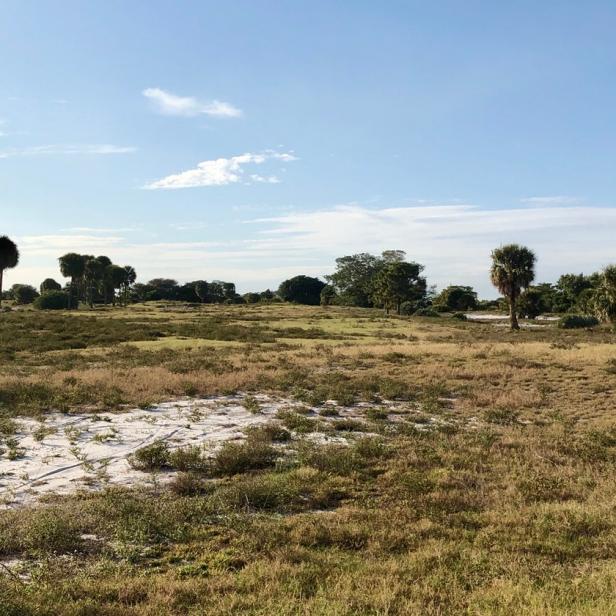Products You May Like
The long-term consequences of golf courses sitting fallow for extended periods of time was a very real concern this past spring, as people around the world retreated indoors into quarantine. The thought of courses being abandoned en masse, out of hardship, was not on my mind in January, however, when I walked the site of West Palm Beach Golf Course. But I did observe, first-hand and in eerie detail, what the powers of time and nature can do to a defenseless property.
West Palm Beach, a municipal course operated by Palm Beach County, closed in 2018 due to prolonged periods of financial difficulty. In just two years the golf course has become overgrown and almost unrecognizable, a silent sanctuary despite being less than three miles from Palm Beach International Airport and sharing borders with I-95, a high school, a large output canal and a residential neighborhood.
The Bermuda grasses, once tightly clipped playing surfaces, had sprouted into a savannah, and original architect Dick Wilson’s large, elevated greens swelled like burial mounds almost completely obscured by growth. The only signs this once might have been a golf course were deep, ragged sand bunkers now matted with weeds, sections of cracking cart paths, and random relics like old ball-washers.
But it occurred to me, walking deeper into the property through the shin-high grass (in golf shoes and socks, thinking my bare ankles would be soon struck by something with fangs), that far from being a dying place, West Palm Beach was actually one of the most profound urban golf settings I’d seen. You’d be hard pressed to find a property with more golf appeal or natural assets, and certainly not one set in the heart of a major metropolitan area.
In the years since it closed, several ideas to revive the course and bolster revenue have been explored, including proposals to incorporate a hotel on-site, or a Topgolf facility.
So far, nothing has stuck, though the latest development is promising. The PGA of America, currently based in adjacent Palm Beach Gardens (the organization will relocate to Frisco, Texas when its new headquarters are complete), is attempting to partner with investors or private entities to rehabilitate the course as a center for stand-alone, community-oriented golf. If those arrangements can be made in the next year and a half, architect Gil Hanse (who is currently building one of the two new PGA of America courses in Frisco) could begin to remodel the West Palm Beach course as soon as the late summer or fall of 2021.
Hanse and design partner Jim Wagner will have enviable material to work with. West Palm Beach, opened in 1947, was one of the first courses of the great public golf boom following World War II.
It’s built on a base of fine sand sprouting with clusters of palmetto, scrub brush, palms, pines and pockets of oak. While Wilson’s routing is quite good, a classic outer-clockwise/inner counter-clockwise rotation, there’s even greater golf potential in treating the land as a natural, never-before developed property. The return to a near-virgin state further highlights its innate character.
“We’re going to treat it as a found site,” Hanse told me. “The course that we keep talking about and keep coming back to, because of the vegetation and elevation and the sand, is Kingston Heath,” he said, referring to one of the most renowned courses of Melbourne, Australia’s Sand Belt.
“I know that’s a lofty standard, and I don’t anticipate that we’re going to build the next Kingston Heath, but it’s a really good model for us. Both Jim and I are really enthused about the potential as a found site.”
A Kingston Heath-inspired design in this location would marry the site’s scruffy qualities with broad, rambling holes that bleed out into areas of native sand and vegetation. Drainage is always a concern in coastal Florida, but the goal will be to cultivate dry, bouncy turf and a style of architecture that plays with a rolling ball.
If it comes to fruition, Hanse believes West Palm Beach can become the kind of place that develops its own unique golf culture. “One of the cool things Seth Waugh (CEO of the PGA of America) has been talking about has been the mandate to make the golf course part of the community.” That could entail music and food trucks, a brewery or farmers market, or anything else that creates synergy between the golf course and the West Palm Beach neighborhoods.
Before any of this happens, West Palm Beach County and the PGA of America will need to raise the necessary funds for the course and construction of a new clubhouse, most likely relocated on the east side of the property (the county razed the old clubhouse several years ago). In the meantime, Hanse and Wagner will continue to develop ideas about how to maximize this rare public golf opportunity.
“We’ve been asked if we can do something special, and both Jim and I believe that we can,” he says. “Everything about it just feels good. The site has tremendous potential to build both a compelling golf course and just a better community spirit.”


